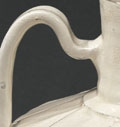J.J. Lally & Co., Oriental Art / New York City, New York
MenuPast Exhibition
The Gordon Collection:
Chinese Ceramics and Works of Art
March 12 - April 4, 2009
46.
A WHITE-GLAZED CIZHOU POTTERY LOTUS-PETAL CARVED EWER
Northern Song Dynasty (A.D. 960-1127)
the well-potted body of almost hemispherical form, with four rows of overlapping lotus petals boldly carved in high relief around the steep sides, the broad sloping shoulders decorated to match with overlapping petals radiating from a stepped collar at the base of the cylindrical neck, with a high arching strap handle joining the neck to the shoulder on one side, opposite an upward slanting faceted tubular spout, covered with a creamy white slip under a clear glaze, the glaze thinning to a lighter tone over the sharp edges of the petal motifs giving crisp definition to the design, and ending unevenly around the splayed wedge-shaped footrim, the unglazed stoneware body burnt to a pale tan-brown color in the firing.
Height 6 1⁄2 inches (16.5 cm)
Compare the more elaborately carved Cizhou ewer of related type illustrated in Sekai Toji Zenshu (Ceramic Art of the World), Tokyo, 1975, Vol. 12, no. 224. Compare also the ewer of the same type with more elaborate design, in the collection of the Tokyo National Museum, in Illustrated Catalogues of the Tokyo National Museum, Vol. I: Chinese Ceramics, Tokyo, 1988, no. 546, p. 136, illustrated again by Yutaka Mino in Freedom of Clay and Brush through Seven Centuries in Northern China: Tz’u-chou Type Wares, 960-1600 A.D., Bloomington, 1980, pl. 10, p. 45.
北宋 磁州刻花蓮瓣紋執壺 高 16.5 厘米
